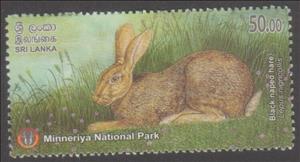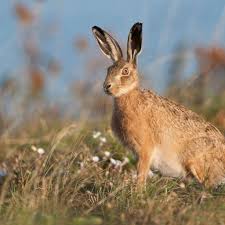Stamp: Black-Naped Hare (Lepus nigricollis) (Sri Lanka 2025)
Black-Naped Hare (Lepus nigricollis) (Sri Lanka 2025)
26 June (Sri Lanka ) within release Minneriya National Park (2025) goes into circulation Stamp Black-Naped Hare (Lepus nigricollis) face value 50 Sri Lankan rupee
| Stamp Black-Naped Hare (Lepus nigricollis) in catalogues | |
|---|---|
| Colnect codes: | Col: LK 2025.06.26-06 |
Stamp is horizontal format.
Issued in single-design panesAlso in the issue Minneriya National Park (2025):
- Stamp - Asian Openbill Stork (Anastomus oscitans) face value 50;
- Souvenir Sheet - Asian Openbill Stork (Anastomus oscitans) face value 50;
- Stamp - Black-Naped Hare (Lepus nigricollis) face value 50;
- Souvenir Sheet - Black-Naped Hare (Lepus nigricollis) face value 50;
- Stamp - Brahminy Kite (Haliastur indus) face value 50;
- Souvenir Sheet - Brahminy Kite (Haliastur indus) face value 50;
- Stamp - Indian Pangolin (Manis crassicaudata) face value 50;
- Souvenir Sheet - Indian Pangolin (Manis crassicaudata) face value 50;
- Stamp - Indian Star Tortoise (Geochelone elegans) face value 50;
- Souvenir Sheet - Indian Star Tortoise (Geochelone elegans) face value 50;
- Stamp - Painted Stork (Mycteria leucocephala) face value 50;
- Souvenir Sheet - Painted Stork (Mycteria leucocephala) face value 50;
- Stamp - Sri Lankan Elephant (Elephas maximus maximus) face value 50;
- Souvenir Sheet - Sri Lankan Elephant (Elephas maximus maximus) face value 50;
- Stamp - Sri Lankan Jackal (Canis aureus naria) face value 50;
- Souvenir Sheet - Sri Lankan Jackal (Canis aureus naria) face value 50;
- Stamp - Sri Lankan Sloth Bear (Melursus ursinus inornatus) face value 50;
- Souvenir Sheet - Sri Lankan Sloth Bear (Melursus ursinus inornatus) face value 50;
- Stamp - Yellow-Striped Chevrotain (Moschiola kathygre) face value 50;
- Souvenir Sheet - Yellow-Striped Chevrotain (Moschiola kathygre) face value 50;
Stamp Black-Naped Hare (Lepus nigricollis) it reflects the thematic directions:
Animals are multicellular, eukaryotic organisms of the kingdom Animalia (also called Metazoa). All animals are motile, meaning they can move spontaneously and independently, at some point in their lives. Their body plan eventually becomes fixed as they develop, although some undergo a process of metamorphosis later on in their lives. All animals are heterotrophs: they must ingest other organisms or their products for sustenance.
Forestry is the science and craft of creating, managing, planting, using, conserving and repairing forests and woodlands for associated resources for human and environmental benefits. Forestry is practiced in plantations and natural stands. The science of forestry has elements that belong to the biological, physical, social, political and managerial sciences. Forest management plays an essential role in the creation and modification of habitats and affects ecosystem services provisioning
Hares and jackrabbits are mammals belonging to the genus Lepus. They are herbivores, and live solitarily or in pairs. They nest in slight depressions called forms, and their young are able to fend for themselves shortly after birth. The genus includes the largest lagomorphs. Most are fast runners with long, powerful hind legs, and large ears to dissipate body heat. Hare species are native to Africa, Eurasia and North America. A hare less than one year old is called a "leveret". A group of hares is called a "husk", a "down", or a "drove".
Mammals are any vertebrates within the class Mammalia (/məˈmeɪli.ə/ from Latin mamma "breast"), a clade of endothermic amniotes distinguished from reptiles (including birds) by the possession of a neocortex (a region of the brain), hair, three middle ear bones and mammary glands. All female mammals nurse their young with milk, secreted from the mammary glands. Mammals include the largest animals on the planet, the great whales. The basic body type is a terrestrial quadruped, but some mammals are adapted for life at sea, in the air, in trees, underground or on two legs. The largest group of mammals, the placentals, have a placenta, which enables the feeding of the fetus during gestation. Mammals range in size from the 30–40 mm (1.2–1.6 in) bumblebee bat to the 30-meter (98 ft) blue whale. With the exception of the five species of monotreme (egg-laying mammals), all modern mammals give birth to live young. Most mammals, including the six most species-rich orders, belong to the placental group. The largest orders are the rodents, bats and Soricomorpha (shrews and allies). The next three biggest orders, depending on the biological classification scheme used, are the Primates (apes and monkeys), the Cetartiodactyla (whales and even-toed ungulates), and the Carnivora (cats, dogs, seals, and allies).




